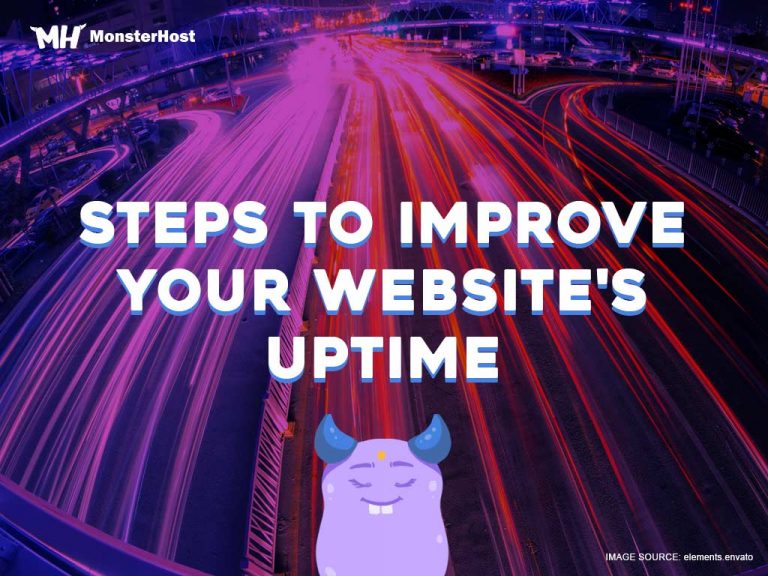Information technology connects us in ways that once resided only in our imagination. It brings businesses and customers closer than ever. As a result, a strong online presence is necessary for your company’s success. Even if you don’t own an e-commerce business, being online allows you to expand and reach significantly more customers who will read your blog or visit your physical store. This is where you’ll find the bulk of your customers and revenue-online.
The idea of having a website is to connect with customers at any time, whether day or night. It allows you to keep your business’ ‘doors’ open at all times. This is referred to as uptime. But, what happens when your website goes offline? What are the effects and how can you improve your website’s uptime? We’ll address all those concerns, but first, let’s breakdown what uptime is.
Table of Contents
What Does Website Uptime Mean?
This term refers to the time a website is available to users over a given period.
Uptime is also a good way to measure how well a Web hosting provider is at keeping their systems up and running. Whenever a hosting provider has a high uptime percentage, it speaks to their reliability, which means your site will stay up and running as well.
Factors that Affect Website Uptime
Downtime is the opposite of Uptime. The goal as mentioned above is to be online 100 % of the time or as close to that as possible. Even though the uptime goal is 100 %, the industry recognises 99.9% uptime as a high availability rate.
So what are the factors that cause your website to go offline?
- Traffic spikes: A spike in traffic to your website, whether it’s legitimate viral traffic or caused by a cyberattack can cause you to go offline.
- Server Overload: Your Web hosting provider stores your website on a server. Whatever happens to the server(s), such as limited resources or viruses will affect your website. And this will have an influence on your site’s uptime.
If you use shared hosting services you are most likely to be affected by a bump in traffic on other sites sharing the server. Consider upgrading to VPS hosting services or dedicated servers.
- Scheduled maintenance: Sometimes downtime is planned. That’s because even excellently optimised websites need scheduled maintenance. You should conduct maintenance during off-peak hours, to minimise possible negative impact.
- Cyberattacks: Hackers can kick your website offline using different tactics. These include overloading the servers with DDoS attacks, stealing security credentials and injecting malicious codes. This forces you to take your site offline to solve the problem. Invest in an SSL certificate.
- Data Centre Problems: Sometimes the hosting company is responsible for the downtime you experience. A website monitoring tool will help you to assess the reliability of your web hosting provider.
- Poor Website Coding issues: Poor programming can result in pointless heavy load on servers, database errors, and can make your website completely unresponsive.
Effects of Downtime on Business
For you to understand just how much uptime contributes to a healthy business, we must first look at what happens when you are affected by downtime. You’ll experience:
– Loss of Brand Credibility
– Increase in Bounce Rate
– A decrease in return site visitors
– Loss in sales and Profits
– Frequent downtime negatively affects your SEO ranking
How Does Uptime Benefit Your Business?
You just learned some of the negative effects of Downtime. Now we’ll breakdown all the way your website and business benefit from reliable uptime.
Customer Trust and loyalty
Providing a solid and uninterrupted service builds your company’s reputation. It also fosters stronger customer relationships. Your brand’s image deteriorates when your website is frequently unreachable by your customers. However, whenever your customers are able to access your website and it operates at a high speed, their trust grows. Not only do they become loyal to you, but they also recommend your business.
This means more customers, thus increased revenue. There is no better marketing than a customer’s recommendation.
Increase In Revenue
When you go offline your products, services and your brand are unreachable to the world for as long as the downtime lasts. When online, you can make sales even in your sleep as long as your website is up and running.
Customers are always available because it’s always daylight somewhere in the world. Strengthen your uptime and watch your revenue skyrocket.
Better SEO Ranking
A reliably high uptime results in an increased SEO ranking on search engines. Your website will show up on the first three pages of a search that’s associated with your keywords, products or services. If you are the first to be suggested, you will experience an increase in customers. This will enhance your bottom-line. Check your SEO ranking.
5 Ways to Improve Website Uptime
It’s evident that uptime is critical to the success of your business. That’s why it is important that you do all in your power to improve your site’s uptime. Here are some ways you can go about doing this.
1. Choose a Reputable Web hosting company
The first step in improving your site’s uptime is selecting a reputable website hosting platform. Not all web hosting platforms operate at the same level. Choose a web service provider that offers 99.9% uptime, transparency and flexibility to scale up your VPS hosting services or upgrade to dedicated servers.
2. Reduce Image Size
The bigger your images the longer the load time. Taking too long to load can cause your page to time out causing certain parts of your site to go offline. You can compress your images. This way they will take up less memory without compromising on image quality or size.
3. Use CND
Content Delivery Network (CDN) allows you to offload some of your site’s content on servers that are closer to your customers. It also improves your load speed, especially for visitors who are geographically distant from your main servers.
4. Website Monitoring Tool
You can never completely prevent downtime but you can keep it at a minimum. Also, the most important part is ensuring you are back online in the soonest possible time. To do this you have to be the first person who recognises that your site is offline. Surely you cannot sit 24/7/365 staring at your website, sporadically hitting refresh. That’s where a website monitoring tool comes in. Website monitoring tools will continuously keep track of your site’s health and status. You will be alerted when there’s an issue. Best of all you will know exactly what is causing your website to go offline. That way, you know exactly what to fix so the majority won’t even notice you were even offline.
5. Communicate Scheduled Downtime Early
We already spoke about planned downtime, which is essential to the overall health and functionality of your website. But whether your downtime is planned or otherwise, you should reach out to your customers using your social media. Keep them ‘in the know’ and they will respect that and stay loyal. Inform customers beforehand of planned downtime, even though it’s not within peak hours. Your customers will understand and respect this courtesy.
How To Calculate Uptime
A site’s uptime is calculated based on the number of hours that the web hosting server is available during a given period. Here’s how it is calculated:
Total number of hours the website is available divided by the total number of hours per year multiplied by 100.
That is, uptime = (Total available time/total time per year) x 100
Conclusion
Being online is not the only thing that guarantees the success of your website or business. However, it is a key aspect. To ensure you limit the amount of downtime you experience, install support systems and monitoring software. Also ensure that you are using use a reputable website hosting provider to house your website. The best hosting providers, offer 99.9% uptime.
Since you can’t always prevent your site from going offline, ensure you have measures in place to get it up and running in no time.
Do you have more questions or concerns about uptime and its impact on your business? Leave a comment down below and we’d be happy to continue the conversation.






